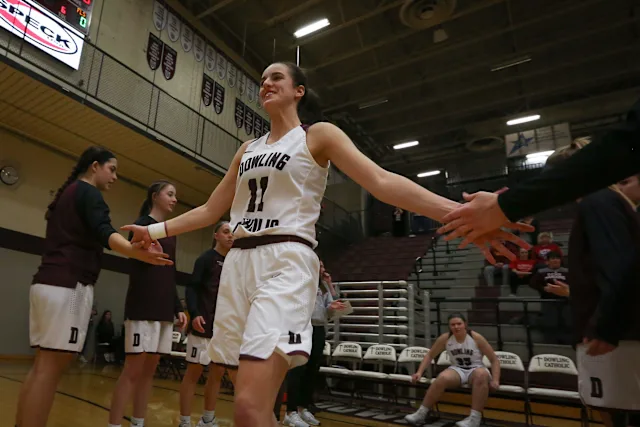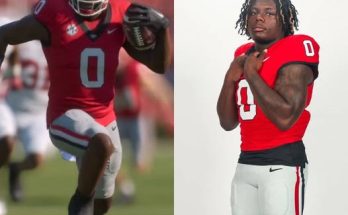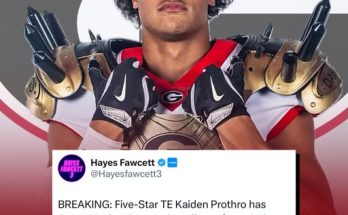Indiana Fever star Caitlin Clark has never been shy about her competitive fire, and that intensity stretches far beyond the WNBA court. Long before she became one of the most electrifying players in women’s basketball, Clark’s drive was forged in the fierce battles she waged during her high school days. Among those formative experiences, her rivalry with a particular high school opponent remains a defining and deeply personal part of her journey. Even now, as she dazzles crowds in the professional ranks, that old rivalry still burns brightly — a testament to the lasting impact of competition and the personal motivations that fuel greatness.
Growing up in West Des Moines, Iowa, Caitlin Clark’s basketball journey was marked by rapid ascension and relentless work ethic. She burst onto the scene early, drawing attention for her extraordinary scoring ability, court vision, and a fearless approach to the game. From the start, it was clear she was destined for something special. But what made Clark truly exceptional was not just raw talent; it was the competitive spirit she cultivated by facing and sometimes clashing with the best players around her, including one particular high school rival who seemed to bring out the very best — and sometimes the very worst — in her.
Their rivalry began during their sophomore years at competing high schools within Iowa’s competitive basketball landscape. This rival, who played for a neighboring school with a strong program, quickly became the benchmark against which Clark measured her own progress. Every time their teams faced off, the stakes felt enormous, not just because of the implications for playoffs or rankings, but because it was a personal contest between two fierce competitors. The battles were always intense, the games filled with moments of high drama, clutch shots, and sometimes heated exchanges that reflected the deep emotional investment both players had in the outcomes.
What set their rivalry apart wasn’t just the on-court competition but the underlying tension that lingered long after the final buzzer. Caitlin Clark has openly admitted that, even today, she finds it hard to fully shake the feelings she has toward that old rival. While many athletes move past high school rivalries as they advance in their careers, Clark’s connection to this particular competitor runs deeper. It symbolizes a critical part of her growth — a challenge she had to overcome, a fire she had to keep stoked to push herself beyond limits.
Clark’s honesty about her lingering feelings toward this high school adversary reveals an important insight into the mindset of elite athletes. The ability to maintain motivation, even from past conflicts, can drive someone to sustain an extraordinary level of performance. In Clark’s case, that unresolved rivalry continues to be a source of fuel — a reminder of the battles that shaped her and a challenge that she’s never quite forgotten.
Fans and analysts alike often focus on Caitlin Clark’s incredible skills: her pinpoint three-point shooting, her uncanny court awareness, and her ability to take over games in the blink of an eye. But behind those highlight-reel moments lies a story of persistence, grit, and a relentless competitive spirit that was honed through encounters like the one with her high school rival. That opponent forced Clark to elevate her game, to learn how to handle pressure, and to cultivate a mental toughness that is essential at the professional level.
Interestingly, Clark has shared in interviews that while she respects her rival’s talents and acknowledges their impact on her development, there is also a stubborn refusal to fully embrace camaraderie with that player. It’s less about personal dislike and more about the competitive tension that defines them. Rivalries, after all, thrive on a mix of respect and friction — the two players pushing each other to new heights but never fully comfortable in each other’s presence. This dynamic is a testament to the intense passion that Clark brings to basketball.
What makes this rivalry especially compelling is how it exemplifies the importance of competition in personal growth. For Clark, that rivalry was not just about beating one player or one team; it was about surpassing limits and proving something to herself. It was about learning how to thrive under pressure, how to channel frustration into focus, and how to develop a mental edge that separates good players from great ones. The fact that she still “can’t stand” that rival, in her own words, suggests that the rivalry remains a meaningful part of her identity — a symbol of everything she’s worked to overcome and achieve.
As Clark transitioned from high school to college, and now to the professional ranks with the Indiana Fever, that fierce competitive nature has only intensified. Every game is an opportunity to prove herself, not just to fans or coaches, but to the competitive spirit that was forged in those high school battles. She carries the lessons and the fire from that rivalry into every dribble, pass, and shot. It’s what drives her to push through adversity, to recover from setbacks, and to keep raising her game.
Her story is a powerful reminder that behind every great athlete is a journey shaped by personal challenges, rivalries, and the drive to be better. For Caitlin Clark, the rivalry she had with her high school opponent is more than just a memory — it’s an ongoing source of inspiration and motivation. It’s the kind of deep, personal competition that stays with you, pushing you forward long after the final whistle has blown.
In a sport where mental toughness is as crucial as physical skill, Clark’s candid admission about her feelings toward her old rival provides a rare window into the emotional underpinnings of elite competition. It highlights how rivalries can serve as both a crucible and a catalyst for growth, helping athletes discover strengths they didn’t know they had. For Clark, the unresolved tension with her rival is a testament to the power of competition to shape character and fuel excellence.
As the Indiana Fever continue their quest for success, Caitlin Clark remains a player to watch — not just because of her dazzling talent, but because of the unrelenting fire that burns within her. That fire was kindled in part by her rivalry with her high school adversary, a rivalry that still holds a special place in her heart. It’s a rivalry that keeps her sharp, hungry, and ready to face any challenge that comes her way.
In the end, Clark’s story is about much more than basketball. It’s about the complex emotions and personal battles that drive us all to be better. It’s about how competition, even when it’s tough and uncomfortable, can inspire greatness. And it’s about how a single rivalry from years ago can leave a lasting impact on a player who continues to make history on the biggest stages.
Caitlin Clark’s ongoing inability to fully let go of her high school rival is not a weakness — it’s a strength. It’s a reminder that the most meaningful rivalries are the ones that push us to our limits, challenge our resolve, and inspire us to become the best versions of ourselves. For Clark, that rivalry remains a powerful part of her legacy, fueling her passion and her pursuit of excellence every time she steps on the court.
As fans, we watch in awe as Caitlin Clark lights up the game with her remarkable skill and fearless heart. But behind every incredible performance is a story of fierce competition and personal growth that began years ago, in the intensity of a high school rivalry. That rivalry might still be a source of frustration for Clark, but it’s also a cornerstone of the incredible player she has become — a player who refuses to back down, who thrives under pressure, and who continues to chase greatness with an unyielding fire.



